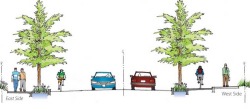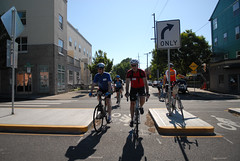After a press conference in Portland last week, the City of Portland and Mayor Adams put out a statement that included a list of “priority projects” they’d like to see funded in the upcoming rewrite of the transportation bill. I sort of glossed over the list in my story about that press conference, so I wanted to focus your attention on it again.
Below is the list of projects (full project descriptions here) followed by some clarifying comments about them by Mayor Adams’ Transportation Policy Director Catherine Ciarlo.

SW Capitol Highway – $10 million to improve SW Capitol Highway between SW Multnomah Boulevard and SW Taylors Ferry Road. Project website (PBOT).
102nd Street Boulevard Improvements/Gateway Phase II – $3 million to implement Phase II of a project targeted at improving NE 102nd Avenue – the main commercial corridor through the Gateway District of East Portland. Project website (PBOT).
Portland to Lake Oswego Streetcar – $163 million for the Portland to Lake Oswego streetcar line. The project will extend the existing Portland streetcar line from SW Lowell Street in the South Waterfront district to Lake Oswego. Project website (Metro).
Portland Bicycle Boulevard Project – $25 million for over 100 city-wide miles of bike boulevards. PBOT’s bike boulevard website.
Portland Streetcar Planning and Alternatives Analysis – $5 million for streetcar planning and alternatives analysis.
Division Street Reconstruction/Brooklyn Creek Basin – $3.6 million, roughly one-third of which would construct green-street projects in targeted combined sewer catchment areas to control stormwater runoff from more than eight acres of public streets between Mt. Tabor and the Willamette River.
Union Station – $24 million for the next phase of improvements to rehabilitate Union Station.
I asked Catherine Ciarlo in the Mayor’s Office how this list came together. She first wanted to make it clear that getting federal dollars is imperative because there’s very little local transportation money and “it’s declining all the time.” The only way Portland can do large projects, she said, is to leverage large amounts of federal funding.
“It’s a mix of looking at needs we have as a city, lining up the projects that will be the most competitive in the pots of money we submit them to, and looking at the strategic possibility of factors that those will get funded.”
— Catherine Ciarlo, Mayor Adams’ Office
As for these specific projects, Ciarlo said, “They represent is a cross-section of the bigger projects the City of Portland is working to move forward… They have been weighed in on and vetted by all of City Council.” Key to what makes it onto the list, added Ciarlo, is an effort to be as strategic as possible. It’s a combination of matching projects to particular funding programs, to the particular interests of our congressional delegation, and other subjective factors. “It’s a mix of looking at needs we have as a city, lining up the projects that will be the most competitive in the pots of money we submit them to, and looking at the strategic possibility of factors that those will get funded.”
Ciarlo says streetcar projects are a good example:
“Portland is known nationally for our streetcar successes [as this recent USA Today article attests] and it’s strategically to our advantage to put something forward to Congress that says we’re building on that system.”
The bike boulevard funding request jumps out as the most bike-centric project of them all. Ciarlo says Mayor Adams specifically scheduled a trip to Beach School while Congressmen Jim Oberstar (D-MN) and Peter DeFazio (D-OR) were in town last week to highlight the City’s work on them. “We wanted the Mayor to spend time with the Congressmen, remind them about our bike boulevard request, show them what they look like, and how bike boulevards connect to our Safe Routes to Schools program.”
The Obama Administration recently spurred momentum on a reauthorization of the federal transportation bill by announcing a $50 billion infrastructure spending plan. It will be interesting to see how/if this list evolves as the transportation bill becomes more of a reality.


